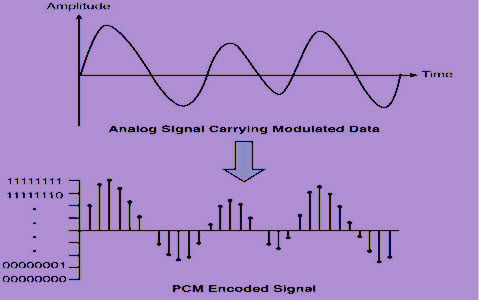Pulse Code Modulation
Modulation is the process of varying one or more parameters of a carrier signal in accordance with the instantaneous values of the message signal.
The message signal is the signal which is being transmitted for communication and the carrier signal is a high frequency signal which has no data, but is used for long distance transmission.
There are many modulation techniques, which are classified according to the type of modulation employed. Of them all, the digital modulation technique used is Pulse Code Modulation (PCM).
A signal is pulse code modulated to convert its analog information into a binary sequence, i.e., 1s and 0s. The output of a PCM will resemble a binary sequence. The following figure shows an example of PCM output with respect to instantaneous values of a given sine wave.

Pulse code modulation (PCM) is a digital representation of an analog signal that takes samples of the amplitude of the analog signal at regular intervals. The sampled analog data is changed to, and then represented by, binary data. PCM requires a very accurate clock.
The word pulse refers to pulses found in transmission lines, which are a natural consequence of two other almost simultaneously evolved analog methods: pulse width modulation and pulse position modulation, where each uses discrete signal pulses of varying widths or positions.
In Pulse Code Modulation, the message signal is represented by a sequence of coded pulses. This message signal is achieved by representing the signal in discrete form in both time and amplitude.
Resource/s:
Analog Pulse Modulation. (n.d.). Retrieved from https://www.tutorialspoint.com/principles_of_communication/principles_of_communication_analog_pulse_modulation.htm
No comments:
Post a Comment